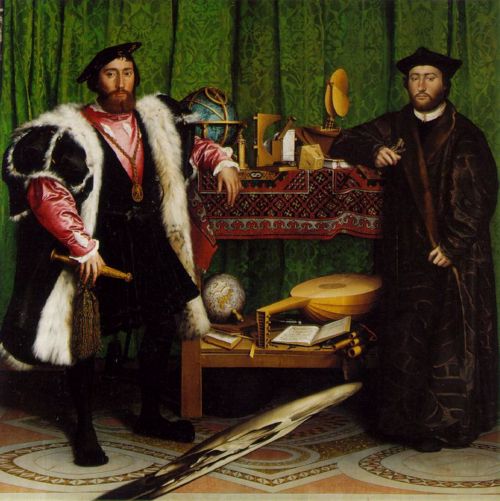The Ambassadors (painting): Difference between revisions
Jump to navigation
Jump to search

imported>Petréa Mitchell m (→On the Web: Alphabetization) |
imported>Subpagination Bot m (Add {{subpages}} and remove any categories (details)) |
||
| Line 1: | Line 1: | ||
{{subpages}} | |||
Jean de Dinteville and Georges de Selve ('''The Ambassadors''')<ref>[http://gallery.euroweb.hu/html/h/holbein/hans_y/1535a/ The Ambassadors (1533) in London]</ref> is a painting by [[Hans Holbein the younger]] painted in 1533. It's held by the National Gallery in London, England and was bought in 1890. It is painted with a meticulous eye for detail, and its inner meaning is controversial. At right is Georges de Selve, aged 25, Bishop of Lavaur. According to [[John North]]<ref>[http://www.amazon.com/Ambassadors-Secret-Holbein-World-Renaissance/dp/1852853301 The Ambassador's Secret: Holbein and the World of the Renaissance, ISBN-10: 1852853301]</ref> the scene depicted is exactly 1,500 years after [[Christ]]'s [[crucifixion]], that is [[Good Friday]] (April 11th) 1533, which gives the anamorphic skull particular significance. | Jean de Dinteville and Georges de Selve ('''The Ambassadors''')<ref>[http://gallery.euroweb.hu/html/h/holbein/hans_y/1535a/ The Ambassadors (1533) in London]</ref> is a painting by [[Hans Holbein the younger]] painted in 1533. It's held by the National Gallery in London, England and was bought in 1890. It is painted with a meticulous eye for detail, and its inner meaning is controversial. At right is Georges de Selve, aged 25, Bishop of Lavaur. According to [[John North]]<ref>[http://www.amazon.com/Ambassadors-Secret-Holbein-World-Renaissance/dp/1852853301 The Ambassador's Secret: Holbein and the World of the Renaissance, ISBN-10: 1852853301]</ref> the scene depicted is exactly 1,500 years after [[Christ]]'s [[crucifixion]], that is [[Good Friday]] (April 11th) 1533, which gives the anamorphic skull particular significance. | ||
| Line 5: | Line 7: | ||
== On the Web == | == On the Web == | ||
<references/> | <references/> | ||
Revision as of 01:34, 15 November 2007
Jean de Dinteville and Georges de Selve (The Ambassadors)[1] is a painting by Hans Holbein the younger painted in 1533. It's held by the National Gallery in London, England and was bought in 1890. It is painted with a meticulous eye for detail, and its inner meaning is controversial. At right is Georges de Selve, aged 25, Bishop of Lavaur. According to John North[2] the scene depicted is exactly 1,500 years after Christ's crucifixion, that is Good Friday (April 11th) 1533, which gives the anamorphic skull particular significance.
